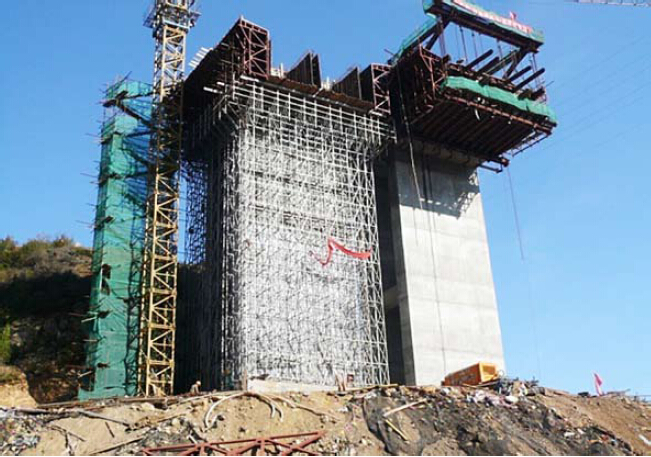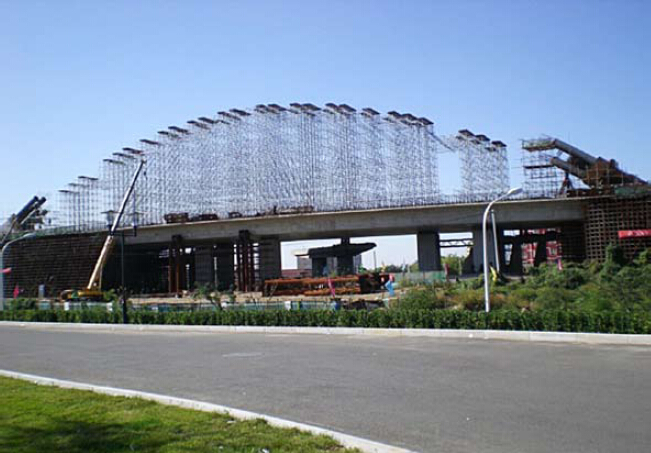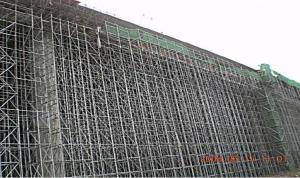Tower Scaffolding for Formwork and Scaffolding Build
- Loading Port:
- Tianjin
- Payment Terms:
- TT OR LC
- Min Order Qty:
- 50 m²
- Supply Capability:
- 1000 m²/month
OKorder Service Pledge
Quality Product, Order Online Tracking, Timely Delivery
OKorder Financial Service
Credit Rating, Credit Services, Credit Purchasing
You Might Also Like
Tower Scaffolding
Shoring tower is an effective supporting system. It is easy to assemble and dismantlement, and
has excellent stability and bearing capacity. It has been widely used in the construction of industry
& residential buildings , bridges, tunnels and dam project, etc.
Characteristics:
◆ High degree of standardization.
◆ Easy storage and transportation


- Q:How does steel formwork prevent concrete mixture separation during pouring?
- Steel formwork prevents concrete mixture separation during pouring by providing a rigid structure that holds the concrete in place until it sets. The steel panels and reinforcements prevent the concrete from spreading or leaking out, ensuring that it maintains its desired shape and consistency. Additionally, the tight joints and connections in the steel formwork prevent any gaps or spaces where the concrete could potentially escape, resulting in a more uniform and solid structure.
- Q:Can steel formwork be used for complex geometric designs?
- Yes, steel formwork can be used for complex geometric designs. Steel is a versatile material that can be easily shaped and molded into various intricate forms, making it suitable for complex geometric designs. Steel formwork allows for precise and accurate construction, ensuring that the desired shape and dimensions of the design are achieved. Additionally, the strength and durability of steel make it suitable for supporting the weight and pressure exerted during the concrete pouring process. This makes steel formwork a reliable choice for creating complex geometric designs in construction projects.
- Q:Can steel formwork be used for precast concrete facades with intricate patterns?
- Yes, steel formwork can be used for precast concrete facades with intricate patterns. Steel formwork is known for its strength and durability, making it suitable for creating complex and detailed designs. The flexibility of steel allows for the creation of intricate patterns, textures, and shapes on the surface of the concrete. Additionally, steel formwork can be easily adjusted and modified to accommodate any desired pattern or design. This makes it a popular choice for precast concrete facades that require intricate patterns or artistic elements. Overall, steel formwork provides the necessary support and versatility to achieve complex designs in precast concrete facades.
- Q:What are the considerations when designing steel formwork for architectural canopies?
- When designing steel formwork for architectural canopies, several important considerations need to be taken into account. These include: 1. Structural Integrity: The formwork must be designed to withstand the loads imposed by the canopy, including dead loads (self-weight), live loads (such as wind and snow), and any other potential loads such as hanging fixtures. The steel formwork should be structurally robust to ensure the stability and safety of the canopy. 2. Aesthetic Appeal: Architectural canopies are often designed to enhance the overall visual appeal of a building. Therefore, the steel formwork should be designed in a way that complements the desired aesthetics of the canopy. This could involve incorporating decorative elements, such as patterns or textures, into the formwork design. 3. Ease of Installation: The formwork should be designed for easy and efficient installation. This could involve using modular components that can be assembled quickly and easily on-site. It is also important to consider the weight and size of the formwork elements to ensure they can be handled and installed safely. 4. Durability and Maintenance: Steel formwork should be designed to withstand the environmental conditions to which it will be exposed. This may include protection against corrosion, UV radiation, and other potential causes of deterioration. Additionally, the formwork should be designed for easy maintenance and repair, if necessary. 5. Functionality: The formwork must be designed to accommodate any specific functional requirements of the canopy. This could include providing space for utility connections, such as lighting or drainage systems, or incorporating features such as rainwater collection systems. 6. Cost-effectiveness: The design of the steel formwork should consider the overall cost of the canopy project. This includes not only the initial cost of the formwork itself but also factors such as ease of transportation and installation, as well as long-term maintenance costs. Overall, the design of steel formwork for architectural canopies requires a careful balance between structural integrity, aesthetics, functionality, and cost-effectiveness. By considering these considerations, architects and engineers can ensure the successful implementation of canopies that are both visually appealing and structurally sound.
- Q:What are the common design considerations for steel formwork systems?
- To ensure a successful construction project, it is important to take into account several design considerations for steel formwork systems. First and foremost, the load-bearing capacity of the steel formwork system is crucial. It must be able to safely support the weight of the poured concrete as well as any additional loads like workers and equipment. Calculations and analysis are necessary to determine the appropriate thickness and reinforcement of the steel formwork. In addition, the formwork system should be designed to provide sufficient stability and resistance against lateral forces. This is especially important for tall or complex structures that may be subject to significant wind or seismic loads. The design should incorporate bracing and anchorage systems to ensure stability throughout construction. Another important consideration is the ease of assembly and disassembly of the steel formwork system. The design should facilitate efficient installation and removal, minimizing labor and time requirements. This can be achieved through the use of modular components and standardized connections that are easy to assemble and dismantle. Furthermore, the formwork system should be adaptable to any necessary adjustments or modifications. Construction projects often require changes during the process, and the formwork should be flexible enough to accommodate these changes without compromising its structural integrity. Safety is also a crucial aspect in the design of steel formwork systems. The formwork should provide a safe working environment for construction workers, incorporating features like handrails, access platforms, and non-slip surfaces. Additionally, potential hazards such as sharp edges or protruding elements should be considered, and appropriate safety measures should be incorporated to mitigate these risks. Lastly, the durability and longevity of the steel formwork system should be taken into consideration. It should be designed to withstand the harsh conditions of construction, including exposure to weather, chemicals, and repeated use. This may involve the use of corrosion-resistant materials or protective coatings to ensure the longevity and performance of the formwork system. In conclusion, there are several important design considerations for steel formwork systems, including load-bearing capacity, stability against lateral forces, ease of assembly and disassembly, adaptability to changes, safety features, and durability. By carefully considering these factors, engineers can design a steel formwork system that meets the specific requirements of a construction project and ensures its successful execution.
- Q:What are the common challenges faced during steel formwork reassembly?
- During the reassembly of steel formwork, there are various obstacles that may arise. One primary difficulty is guaranteeing the proper alignment and placement of the formwork components. This entails correctly positioning the steel panels, braces, and connecting rods to ensure they are level and secure. Another challenge involves managing the weight and size of the steel formwork components. The steel panels and beams can be cumbersome and bulky, making it arduous to maneuver and assemble them correctly. This necessitates meticulous planning and coordination to ensure the safe handling and positioning of these elements. Additionally, the complexity of the formwork design can present challenges during reassembly. Steel formwork systems can be intricate, incorporating various interlocking components and connections. It is imperative to comprehend the design and assembly instructions to properly reassemble the formwork and ensure its stability and strength. Proper sequencing and timing also pose significant challenges during steel formwork reassembly. The order in which the formwork components are assembled can affect the overall efficiency and effectiveness of the construction process. It is essential to carefully plan the reassembly and coordinate with other construction activities to avoid delays and ensure seamless progress. Lastly, safety remains a major challenge during steel formwork reassembly. Working with heavy steel components can expose workers to risks, including the potential for falls, lifting accidents, or structural failures. Therefore, it is crucial to establish appropriate safety measures, such as utilizing suitable lifting equipment, providing personal protective equipment, and ensuring workers are trained in safe assembly procedures. Overall, the reassembly of steel formwork demands meticulous planning, coordination, and attention to detail to overcome challenges pertaining to alignment, weight, complexity, sequencing, and safety. By effectively addressing these challenges, construction projects can proceed smoothly and efficiently.
- Q:What are the different types of formwork clamps used in steel formwork?
- In steel formwork construction, various types of formwork clamps are commonly utilized. Their purpose is to ensure the firm connection of formwork panels, thereby guaranteeing stability and accuracy during the concrete pouring process. 1. Wedge Clamps: Among the most frequently employed formwork clamps are wedge clamps. These clamps consist of wedge-shaped pieces that are inserted into slots on the formwork panels. As the wedges are driven further into the slots, a tight and secure connection is established between the panels. 2. Rapid Clamps: Rapid clamps are designed for swift and effortless installation and removal. Equipped with a spring-loaded mechanism, these clamps enable easy tightening or loosening with minimal exertion. 3. Turnbuckle Clamps: Adjustable clamps known as turnbuckle clamps provide additional tension and support to the formwork panels. Comprising a threaded rod with a turnbuckle mechanism, these clamps can be tightened or loosened to adjust the tension on the formwork. 4. Pipe Clamps: Pipe clamps employ pipes or tubes to connect and secure the formwork panels. Typically, they consist of U-shaped brackets attached to the formwork panels and pipes or tubes inserted into the brackets to hold the panels together. 5. Panel Clamps: Panel clamps are specially designed to hold large formwork panels together. These clamps usually feature a large, heavy-duty mechanism that can be tightened or loosened to securely hold the panels in place. Each type of formwork clamp possesses its own unique characteristics and advantages. The selection of the appropriate clamp depends on factors such as the size and weight of the formwork panels, the desired level of stability, and the specific requirements of the construction project.
- Q:How does steel formwork handle different concrete strength requirements?
- Steel formwork proves to be a highly versatile and durable solution, capable of effectively managing a wide range of concrete strength demands. Concrete strength is influenced by its mixture proportions, curing conditions, and the quality of materials employed. By providing a reliable and secure framework for pouring concrete, steel formwork plays a pivotal role in fulfilling these requirements. One notable advantage of steel formwork lies in its ability to withstand the immense pressures and strong vibrations encountered during concrete pouring and compaction. This becomes particularly crucial when dealing with high-strength concrete, as it necessitates greater force application to attain the desired density and durability. Thanks to its structural integrity and rigidity, steel formwork can bear these forces without deformations or failures, consequently ensuring a consistent and uniform distribution of the concrete. Another key benefit of steel formwork is its flexibility in terms of shape and size, allowing for customization to accommodate diverse concrete strength specifications. This versatility facilitates the construction of various structural elements, including columns, beams, walls, and slabs, each with unique strength requirements. Additionally, steel formwork can be effortlessly assembled and disassembled, making it adaptable to different projects and enabling the reuse of formwork components. Moreover, steel formwork imparts a smooth and precise finish to the concrete surface, a crucial factor in achieving desired aesthetics and functionality. This is particularly important for architectural or decorative concrete, where a high-quality finish is imperative. The smooth and flat surface provided by steel formwork ensures even curing of the concrete and minimizes the risk of surface defects. To summarize, steel formwork is well-suited to handle diverse concrete strength requirements due to its robustness, durability, adaptability, and ability to deliver a smooth finish. Its strength and flexibility make it an ideal choice for construction projects demanding varying concrete strengths, guaranteeing the successful execution of diverse structural designs and meeting performance expectations.
- Q:What are the considerations when designing steel formwork for retaining structures?
- Several important considerations need to be taken into account when designing steel formwork for retaining structures. These considerations encompass load capacity, durability, ease of installation and removal, flexibility, safety, and cost-effectiveness. To begin with, the formwork must be designed to withstand the weight of the concrete and any additional loads, such as soil or hydrostatic pressure, without deformation or failure. It should possess sufficient strength and stability to support these loads. Furthermore, steel formwork should be designed with durability in mind, capable of enduring the harsh conditions encountered during construction, including exposure to moisture, chemicals, and temperature variations. The material used should have corrosion-resistant properties to ensure long-term durability. In terms of installation and removal, the formwork should be designed to be easily and efficiently assembled and disassembled. This can be achieved through features like modular panels or adjustable components. It should also allow for easy access during concrete pouring and curing. Flexibility is another crucial consideration, as the formwork should be adaptable to different shapes and sizes of retaining structures. This can be achieved through the use of adjustable components or adaptable formwork systems. Such flexibility enables the formwork to be utilized for multiple projects, reducing costs and improving efficiency. Safety is of utmost importance when designing steel formwork. The formwork should provide a safe working environment for construction workers, incorporating features such as anti-slip surfaces, guardrails, and proper anchoring systems. Stability and load distribution should also be considered to minimize the risk of accidents or collapse. Cost-effectiveness should be achieved by optimizing material usage, minimizing waste, and reducing labor requirements. This can be accomplished through efficient design, such as utilizing standardized components or modular systems that can be easily reused. The design should also consider ease of maintenance and repair to minimize long-term costs. In conclusion, when designing steel formwork for retaining structures, it is crucial to consider load capacity, durability, ease of installation, flexibility, safety, and cost-effectiveness. By carefully considering these factors, a well-designed formwork system can be created, ensuring the successful construction of retaining structures.
- Q:Can steel formwork be used for both slab and beam construction?
- Indeed, steel formwork is applicable for both slab and beam construction. Within the construction industry, steel formwork proves to be a flexible and long-lasting alternative for constructing slabs and beams. It furnishes a robust and inflexible framework that can endure the weight and pressure exerted by the poured concrete. With easy assembly and disassembly, steel formwork emerges as a fitting choice for diverse construction undertakings. Its sturdiness and steadiness render it an optimal selection for both slab and beam construction, guaranteeing that the concrete structures adhere to the necessary specifications and can adeptly bear the loads they are designed for.
1. Manufacturer Overview |
|
|---|---|
| Location | |
| Year Established | |
| Annual Output Value | |
| Main Markets | |
| Company Certifications | |
2. Manufacturer Certificates |
|
|---|---|
| a) Certification Name | |
| Range | |
| Reference | |
| Validity Period | |
3. Manufacturer Capability |
|
|---|---|
| a)Trade Capacity | |
| Nearest Port | |
| Export Percentage | |
| No.of Employees in Trade Department | |
| Language Spoken: | |
| b)Factory Information | |
| Factory Size: | |
| No. of Production Lines | |
| Contract Manufacturing | |
| Product Price Range | |
Send your message to us
Tower Scaffolding for Formwork and Scaffolding Build
- Loading Port:
- Tianjin
- Payment Terms:
- TT OR LC
- Min Order Qty:
- 50 m²
- Supply Capability:
- 1000 m²/month
OKorder Service Pledge
Quality Product, Order Online Tracking, Timely Delivery
OKorder Financial Service
Credit Rating, Credit Services, Credit Purchasing
Similar products
New products
Hot products
Hot Searches
Related keywords























